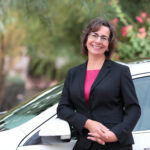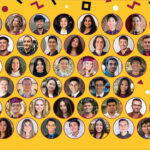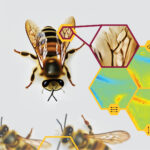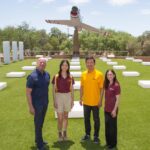
Inspiring the next generation of female engineers at ASU

Above: At GEAR Day, Girl Scout Juniors planned, designed and built boats made of aluminum foil with the help of members from Arizona State University’s Society of Women Engineers. Photographer: Marco-Alexis Chaira/ASU
Girl power reached new heights when about 100 Girl Scouts from Metro Phoenix raided Arizona State University’s Tempe campus for the annual Girl Scouts for Engineering Awareness and Retention Day on Saturday, March 24.
GEAR Day is an outreach initiative hosted by the university’s Society of Women Engineers. The event offers a glimpse of science and engineering through fun activities and demonstrations, such as building circuits and assembling machines. Participants, including Girl Scouts and students from local community schools, have the chance to explore new interests and see the impact of science and engineering on everyday life.
“Engineering is the force that drives innovation and change,” said Gabrielle Mills, president of ASU’s Society of Women Engineers chapter and biomedical engineering major in the Ira A. Fulton Schools of Engineering. “By inspiring young girls to pursue engineering, we’re guaranteeing a future of equal representation in innovation. We’re also ensuring women have an input in the direction of the world’s progress.”
GEAR Day primarily focuses on Girl Scouts because they exemplify common characteristics of engineers: curiosity, courage, experimentation, innovation, leadership and entrepreneurship. The official Girl Scout program introduces girls to science, technology, engineering and mathematics to show them how to make an impact on the world, from gaining computer skills to using scientific methods to conquer challenges.
The core of what many girls at different stages of their lives want to do is help people, explained Alicia Baumann, lecturer of electrical engineering and faculty co-advisor for ASU’s Society of Women Engineers. She believes most girls gravitate toward occupations where they as children saw women helping people.
“Engineering is all about helping people,” said Baumann. “Girls can still have the same impact and make a difference in people’s lives by becoming engineers who solve problems. We need more engineers in today’s society who are compassionate and have an inner urge to help those in need.”
During the morning half of GEAR Day 2018, Girl Scout Brownies created robot names with binary code to learn how this language helps people communicate with computers. They also made slime from cornstarch and water to see how a non-Newtonian fluid can change physical properties, from a liquid to a solid and back, when forces are applied.
“Both are fundamental concepts for software engineering and chemical engineering, respectively, but are presented in such a way that the girls can easily make connections and feel confident asking questions,” said Amber Sogge, a biomedical engineering major and outreach officer for ASU’s Society of Women Engineers chapter. “We want to spark their curiosity for STEM concepts and show them engineering is absolutely worth pursuing if they choose to follow that path.”
Stephanie Jauregui Hidalgo, an alumna who received a bachelor’s degree in management from the W.P. Carey School of Business, attended the event with her 10-year-old daughter, Cooper Hidalgo.
“My daughter has always been very curious and creative,” said Jauregui Hidalgo. “I want her to continue exploring her creativity beyond arts and crafts into science and engineering. These activities open her eyes and show her what she’s capable of accomplishing.”
Cooper Hidalgo is in the fourth grade at SS. Simon and Jude Cathedral School. She’s been eager to join the school’s team for the Honeywell Fiesta Bowl Aerospace Challenge, the largest extracurricular STEM program for grade school and junior high school students in the state. Jauregui Hidalgo said this event is one step toward building her daughter’s confidence so she’s ready to participate in such challenges and further hone in on what she wants to pursue when she gets older.
In addition to exploring their creative sides, the Girl Scouts learned the importance of communicating in a team to design the best prototype. In one activity, they had to work together to plan, design and build a boat from aluminum foil that would float. In another, they built weather stations to learn how meteorologists measure rainfall, wind speed and direction, and temperature.
“The girls are having a great time,” said Barbara Rivera, a troop leader for Girl Scout Juniors. “It’s wonderful the girls are being mentored and inspired by other females in the field during these activities. Engineering isn’t typically seen as a career for women, so it’s great they can interact with women who can help them see their future as engineers.”
The afternoon sessions of GEAR Day were open to both girls and boys from schools across the Phoenix metropolitan area. This was a vital part of the event’s mission to make engineering, as well as other STEM fields, a feasible and desirable career endeavor for the community as a whole.
“We’re including boys and girls in the afternoon session,” said Sogge. “Part of establishing a foundation on which the next generation of female engineers can achieve is not only reliant on empowering girls to pursue engineering but encouraging the boys to value their input and see them as equals.”
The afternoon sessions featured other student organizations in the Fulton Schools to promote diversity in engineering while allowing engineering students to show off their technical skills. Student organizations at the event included the Rossum Rumblers Robotics Club, Students for the Exploration and Development of Space at ASU Rocketry Division, NASA Space Grant Robotics, the Society of Hispanic Professional Engineers and the Micro Air Vehicles ASU Club.
The Rossum Rumblers Robotics Club, a community of students passionate about automation, robotics and technology on the Polytechnic campus, showed GEAR Day attendees how to make air-powered rockets out of nothing but paper, tape and paperclips.
“It’s important to get young girls interested in robotics because the female presence in engineering is low,” said Aaron Dolgin, an electrical systems engineering major and outreach coordinator for the Rossum Rumblers. “Everyone thinks a little differently. The way a male engineer approaches a problem is different from the way a female engineer approaches a problem. Having both perspectives makes solving problems easier.”
The Rocketry Division of Students for the Exploration and Development of Space at ASU focuses on participating — and winning — rocketry competitions by designing and building high-powered rockets. They taught attendees about rocket propulsion. They made a simplified rocket out of a film canister and Alka-Seltzer to demonstrate how chemicals can combine, expand and propel a rocket into space.
“Bringing diversity into the field always brings about new viewpoints and new ideas,” said aerospace engineering major Breydan Dotson, who founded the Rocketry Division club and serves as director of simulation and modeling. “If children have been exposed to these sorts of events, they can see that they have the skills and the brains to be anything they want.”
Keysight Technologies generously donated kits for the morning sessions of the event. Viasat, Inc. gave a presentation on college preparation to the high school students in the afternoon. Additionally, funding from Boeing helped ASU’s Society of Women Engineers purchase the majority of supplies needed for the afternoon sessions. GEAR Day would not have been possible without the generosity of their contributions.


































